This chapter examines policy debates surrounding indigenous education, focusing on the interplay of language, culture, and identity across different national contexts, including China, Mexico, Taiwan, Uganda, and the United States. It highlights the concept of 'indigenous genocide' as government policies lead to the assimilation of indigenous peoples and erasure of their languages and cultures. The authors argue for the empowerment of indigenous peoples in educational policy-making to counteract the negative impacts of assimilation and to preserve their identities.
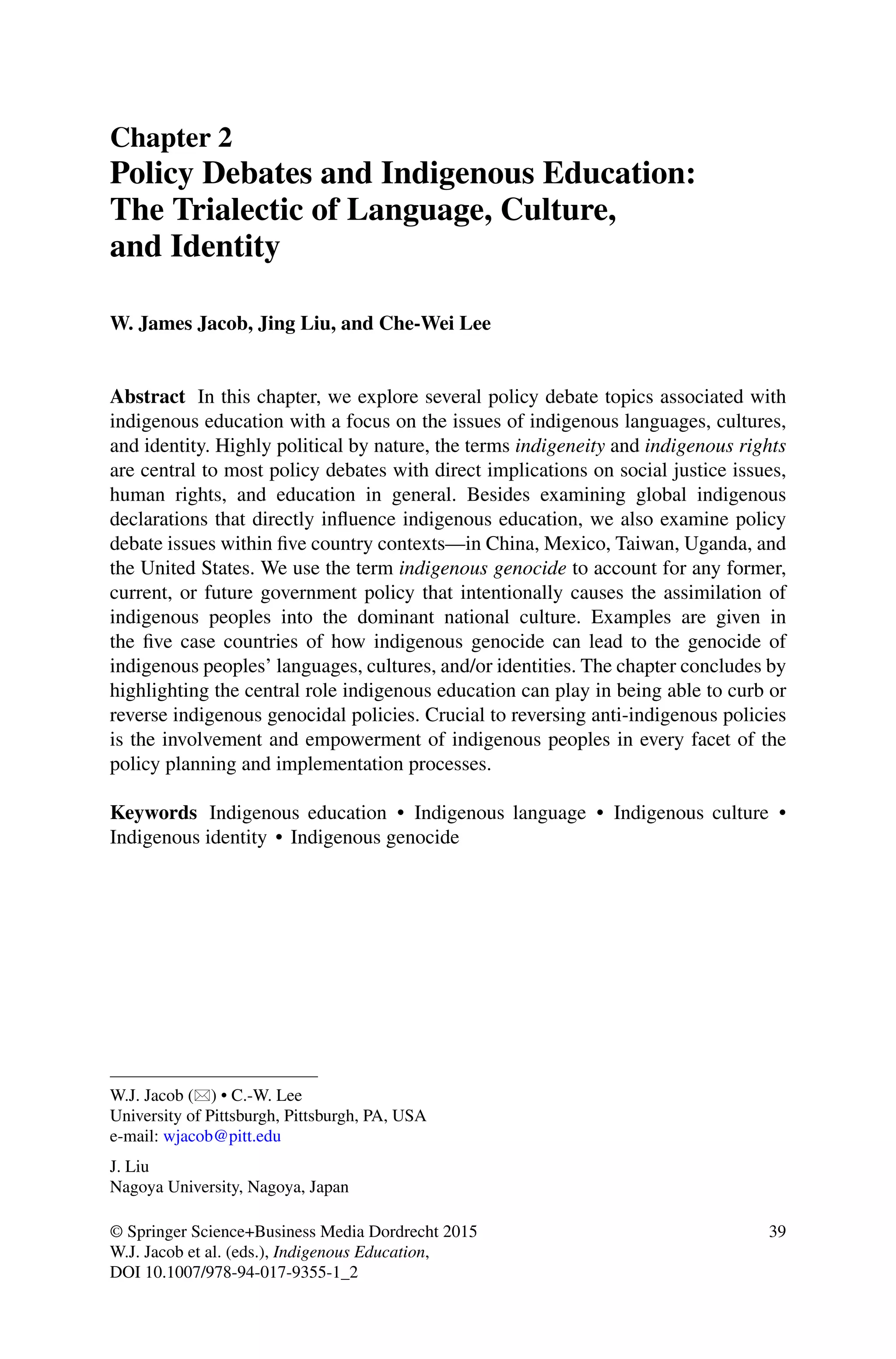
![40 W.J. Jacob et al.
Introduction
Indigenous peoples represent a large proportion of the earth’s population and a
significant segment of our planet’s cultural diversity.1
Scholars argue that there are
between 4,000 and 5,000 (King and Schielmann 2004) and 7,105 languages that are
still spoken by indigenous peoples (Lewis et al. 2013). Most indigenous people
suffer, to one degree or another, from poverty, discrimination, and sociocultural
marginalization issues. Indigenous peoples make up about one third of the 900
million extremely poor rural people living on earth (United Nations 2008). In
this chapter we explore several policy debate topics associated with indigenous
education with a focus on issues of indigenous languages, cultures, and identity.
Many terms have been used to describe indigenous peoples, including Native,
Aboriginal, First Nation, indigenous, and local. Generally speaking, there is no
universal definition that identifies who is an indigenous person. This is especially
true because no single definition can capture the diversity of cultures, languages,
identities, histories, and other circumstances unique to all indigenous peoples. While
some indigenous peoples make up the majority population of a country, the majority
of indigenous peoples comprise only a minority population. The relationships
between indigenous peoples and other groups vary from one country to another.
One widely cited definition of indigenous peoples comes from the Convention of
the International Labour Organization (ILO) in 1989 on “Indigenous and Tribal
Peoples in Independent Countries.” According to this definition, indigenous peoples
are those which, having a historical continuity with pre-invasion and pre-colonial
societies that developed on their territories, consider themselves distinct from other
sectors of the societies now prevailing in those territories, or parts of them. They
form at present non-dominant sectors of society and are determined to preserve,
develop, and transmit to future generations their ancestral territories and their
ethnic identity, as the basis of their continued existence as peoples, in accordance
with their own cultural patterns, social institutions, and legal systems. To respect
indigenous peoples around the world, we capitalize all ethnic, national groups, and
associated adjectives grounded upon the standards of The Chicago Manual of Style
(University of Chicago Press 2010), which not only specifies that “names of ethnic
and national groups are capitalized” but also that “adjectives associated with these
names [should] also [be] capitalized” (p. 401). We argue that writers of indigenous
1
The United Nations estimates that there are some 350 million Indigenous peoples or 5 % of
the world’s population; there are more than 5,000 different groups of Indigenous peoples who
reside in more than 70 countries (see UNESCO 2006, p. 4; United Nations 2008, p. 3). However,
we recognize that the total number of Indigenous peoples is a relative one, in that the number
depends on how the term Indigenous is defined. If you take into account the Indigenous peoples
who reside both within their native home lands as well as the many diaspora groups of Indigenous
peoples who have migrated to other locations, surely this figure would be much higher.](https://image.slidesharecdn.com/jacobliulee2015booksection39-61policydebatesindigenouseducation-150128074332-conversion-gate01/75/Policy-Debates-and-Indigenous-Education-The-Trialectic-of-Language-Culture-and-Identity-2-2048.jpg)
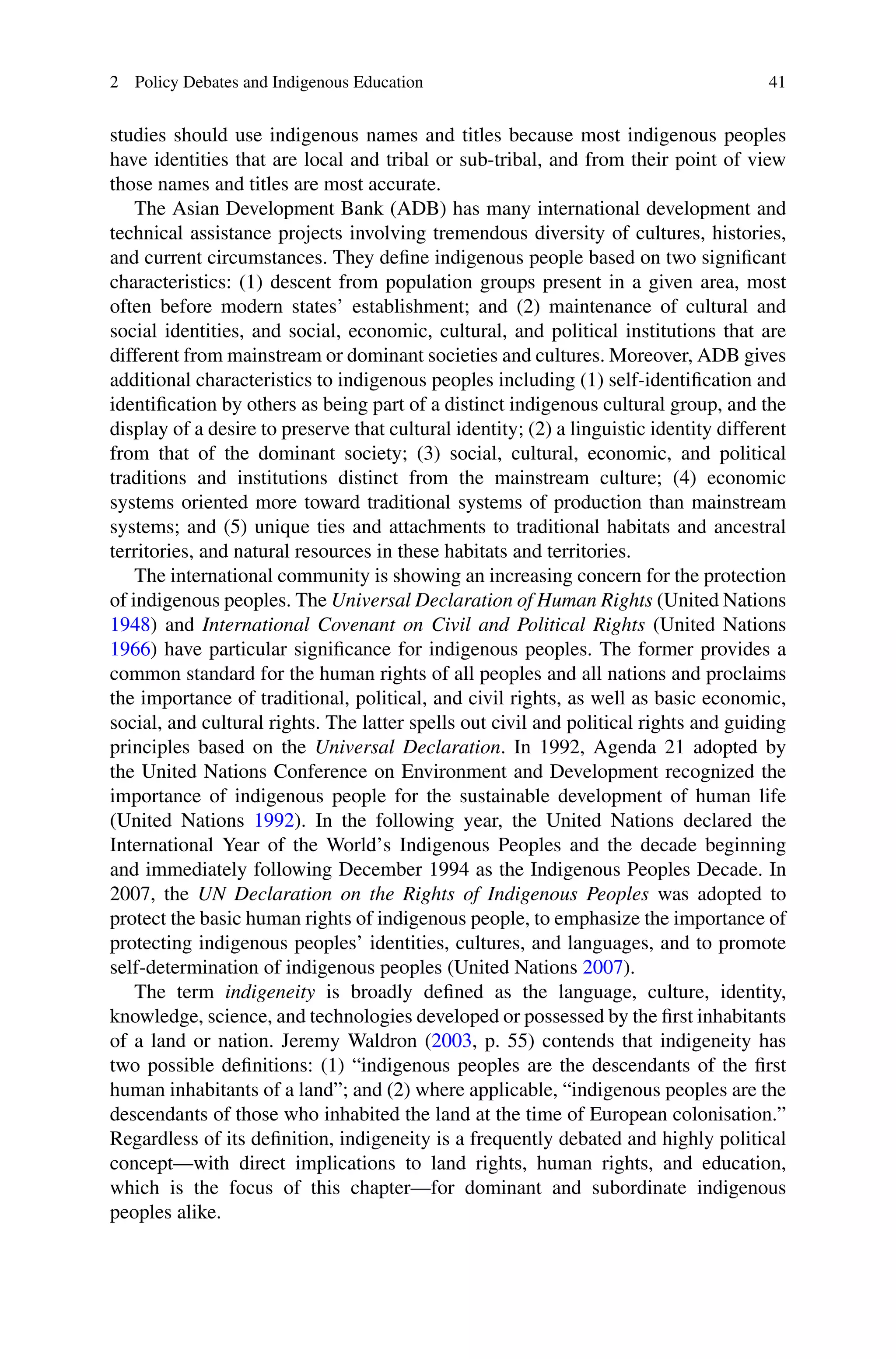
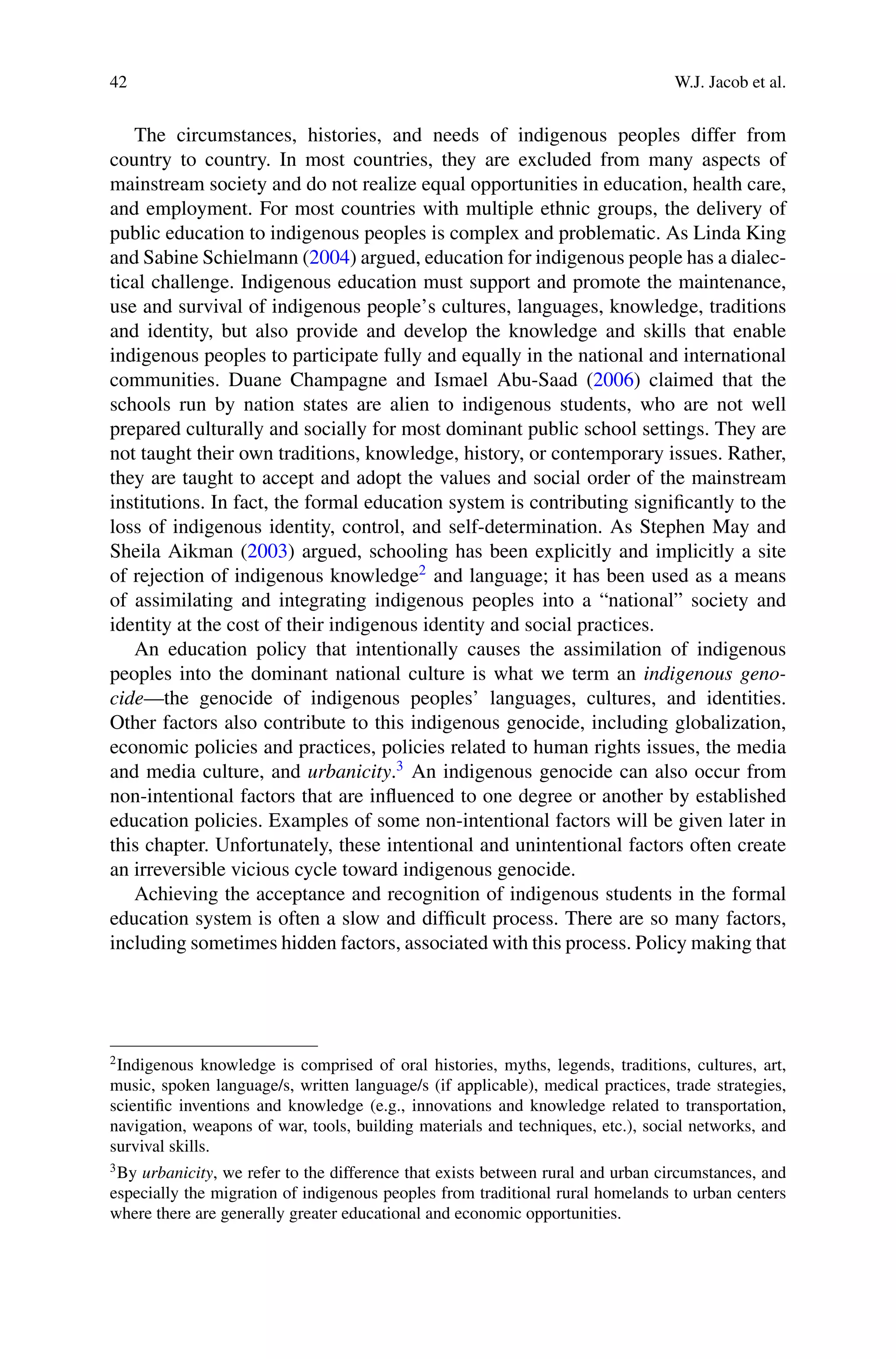
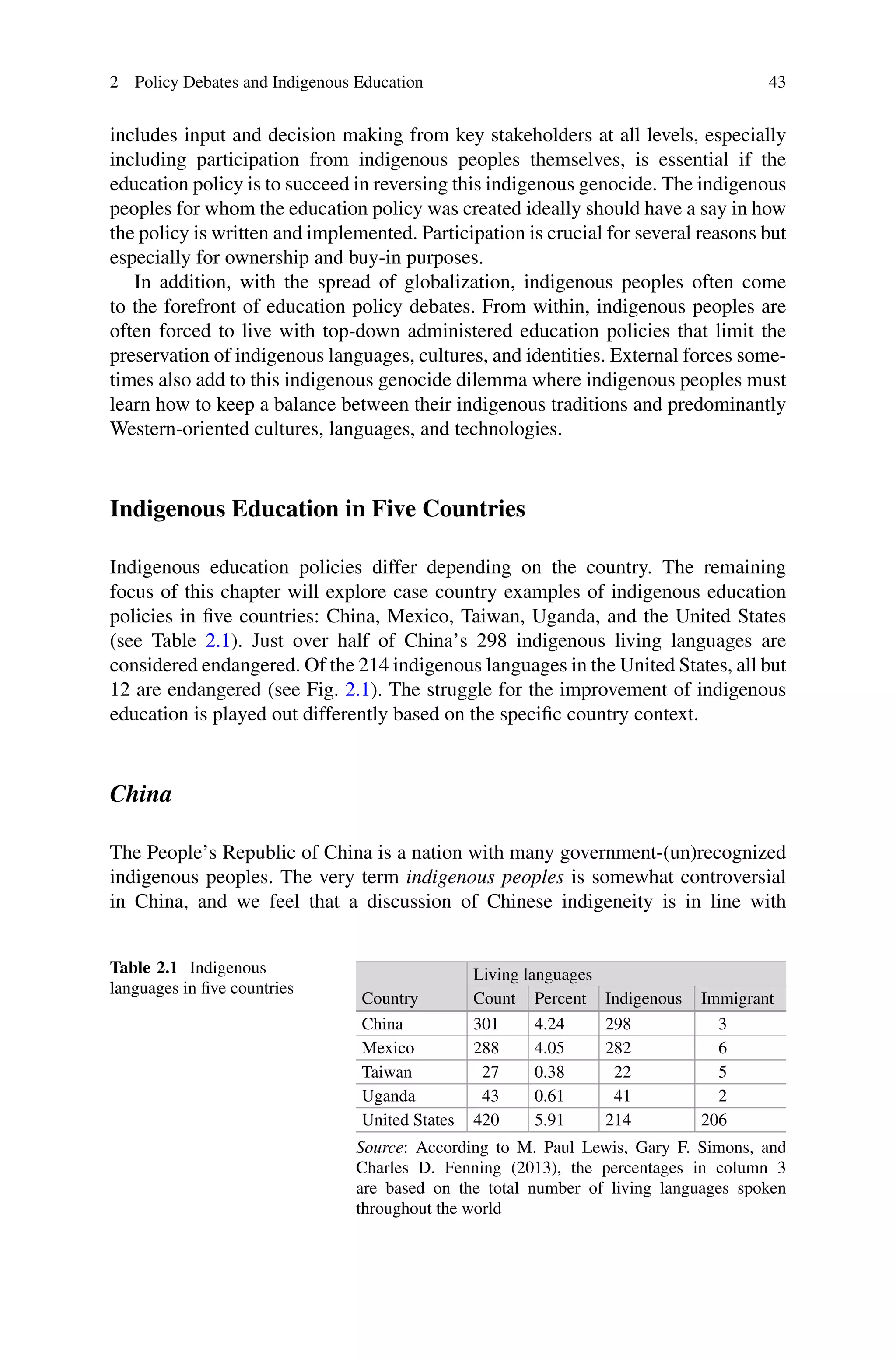
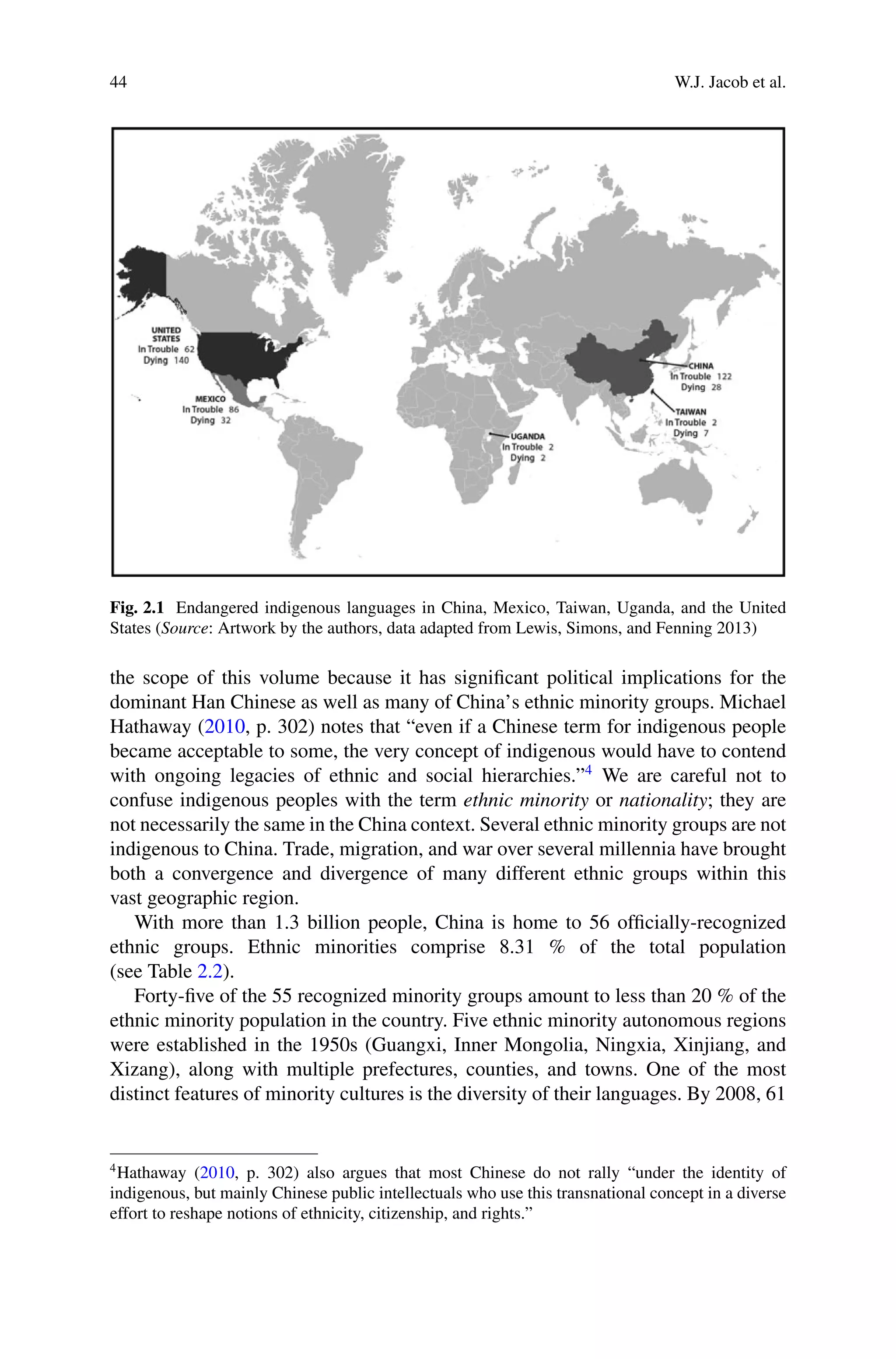
![2 Policy Debates and Indigenous Education 45
Table 2.2 Ten most populous ethnic minority groups in China, 2010
Ethnic minority group name Population % of total population
Zhuang 16,926,381 1.26
Hui 10,586,087 0.79
Manchu 10,387,958 0.78
Uygur 10,069,346 0.75
Miao 9,426,007 0.70
Yi 8,714,393 0.65
Tujia 8,353,912 0.62
Tibetan 6,282,187 0.47
Mongolian 5,981,840 0.45
Dong 2,879,974 0.21
Total ethnic minority population 111,324,800 8.31
Total population of China 1,339,724,852 100.00
Source: Statistics from the population census in 2010, which was the sixth national population
census following those conducted in 1953, 1964, 1982, 1990, and 2000 (National Bureau of
Statistics 2012)
distinct languages had been identified. Many Chinese ethnic minorities are religious,
with approximately half espousing a faith which is distinct from Han culture (Yi
2008).5
China has adopted a series of laws and regulations to help protect the equal
rights, unique cultures, and languages of ethnic minority peoples. The following
are statements of policy in China concerning ethnic minority peoples, cultures, and
languages.
All the nationalities of China are equal [and] every ethnic minority is free to use and develop
their language. (National People’s Congress 1982)
Mandarin Chinese ought to be used for literacy. In ethnic autonomous areas, the local ethnic
languages could be used as the language of instruction : : : . (State Council of the People’s
Republic of China 1988)
Every citizen of China, regardless of sex, ethnic group, economic status or religious belief,
has the right and obligation to education, and enjoys equal educational opportunities to meet
his or her essential needs. (National People’s Congress 1995)
The standardized spoken and written Chinese language (Mandarin) based on the northern
dialect and the Beijing pronouncing system, and the standardized simplified characters
approved by the State Council and in common use in the whole country, shall be popularized
and used as the basic language medium of curriculum and instruction in schools and other
educational institutions of the country. But in schools in which students of minority ethnic
groups constitute the majority, the spoken and written language of the majority ethnic group
or of common use by the local ethnic groups may be used as language media of curriculum
and instruction. (National People’s Congress 1995)
5
We recognize that several Chinese ethnic minority groups have much higher than 50 % of their
population who believe in religion. For instance, Uyghurs in Xinjiang Uygur Autonomous Region
are predominantly Muslim and most Tibetans in the Tibet Autonomous Region observe Tibetan
Buddhism.](https://image.slidesharecdn.com/jacobliulee2015booksection39-61policydebatesindigenouseducation-150128074332-conversion-gate01/75/Policy-Debates-and-Indigenous-Education-The-Trialectic-of-Language-Culture-and-Identity-7-2048.jpg)

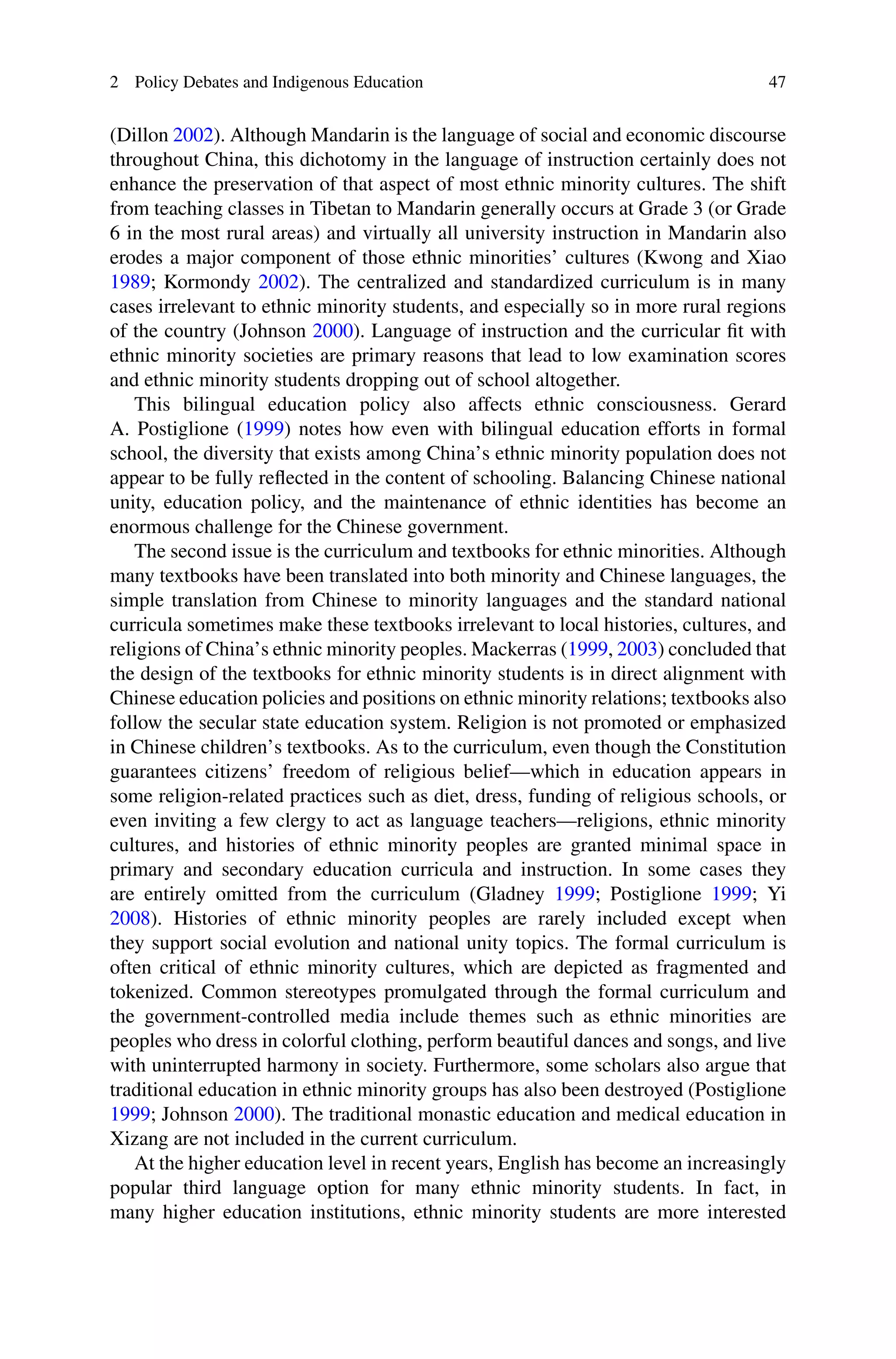
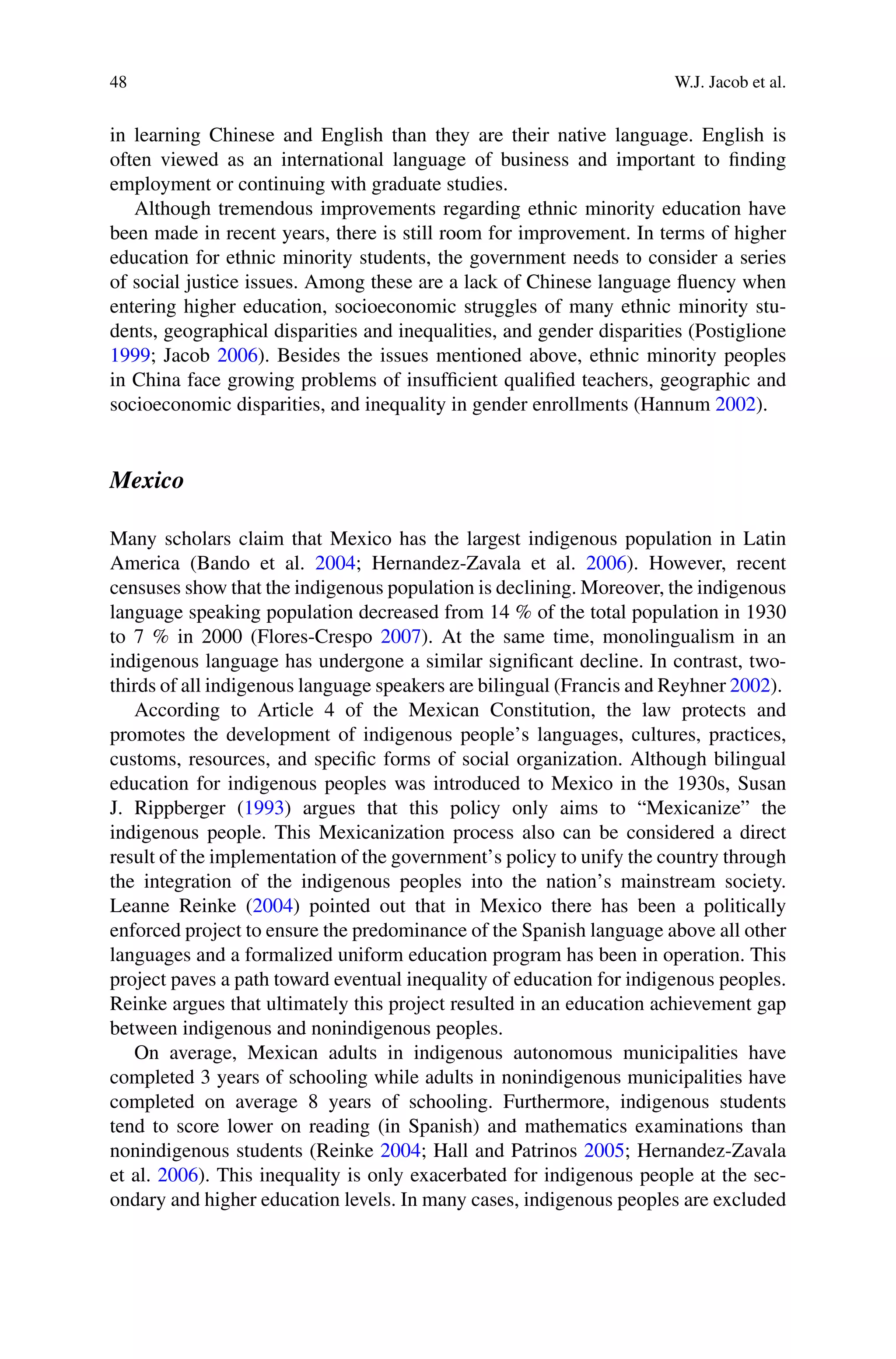
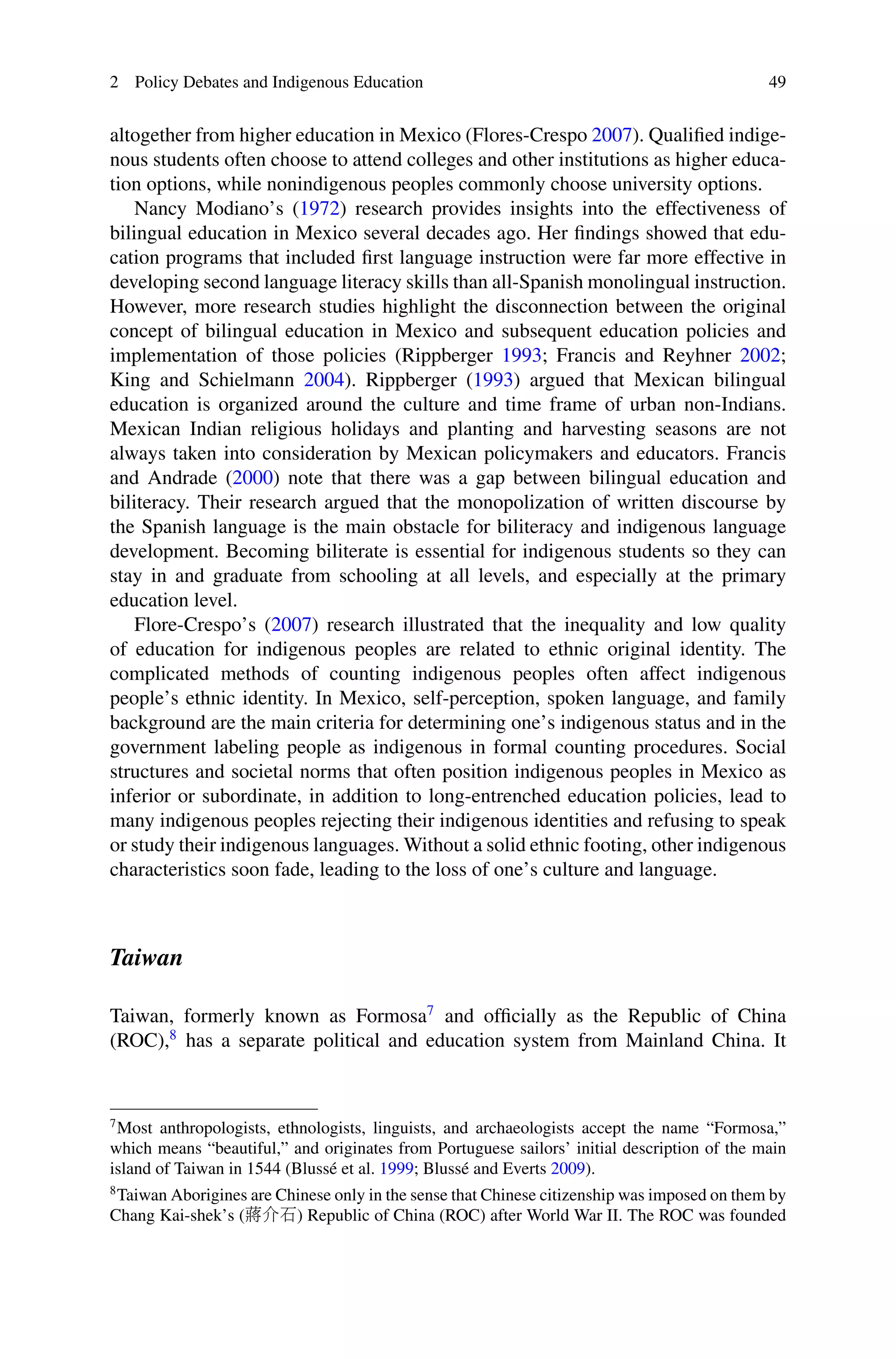
![50 W.J. Jacob et al.
is home to 16 officially recognized tribes—Amis, Atayal, Bunun, Kanakanavu,
Kavalan, Paiwan, Puyuma, Rukai, Saaroa, Saisiat, Sakizaya, Seediq, Tao (or Yami),
Thao, Truku, and Tsou—commonly known as Taiwan Aborigines or the indige-
nous peoples of Taiwan (yuánzhùmínzu, 原住民族)9
(Ministry of Justice 2008;
Council of Indigenous Peoples Executive Yuan [CIPEY] 2012). In July 2012, the
Austronesians of Formosa had a population of 524,059, consisting of nearly 2.25 %
of the total population of 23,268,372 (Department of Household Registration Affairs
[DHRA], Ministry of the Interior 2012). In recent years, the Taiwan Aboriginal
population grew 6.4 % faster than the national average (Department of Household
Registration Affairs 2012). While most Aborigines still reside in predominantly
mountainous and plains regions in the central, southern, and eastern parts of the
country, there is an increasing trend toward urbanization. In order to secure better
employment and education opportunities, a growing number of Taiwan Aborigines
migrate to the urban centers mostly located in the western and northern areas of
the country. Today, roughly 44 % of all Taiwan Aborigines reside in cities (DHRA
2012). Each Aboriginal tribe has its distinct language; all are classified as being
within the Austronesian language family.10
Linguistic and archaeological evidence
suggest Austronesian inhabitation of Formosa for approximately 6,000 years or
perhaps more (Bellwood et al. 1995; Bellwood 2009; Bellwood et al. 2011; Li
1997, 2009). Formosa is recognized by some scholars as the ancestral homeland of
the Austronesian peoples, who today number some 270 million speakers of related
languages, and include many of the indigenous peoples of the Malay Archipelago,
many of the Pacific Islands including New Zealand, and Madagascar (Jacob and
Chen 2012).
in 1912 by Sun Yat-sen, his associates, and supportive civilians. At the end of World War II in 1945,
Japan yielded Taiwan and associated islands to ROC troops. In the last 3 years of the Chinese civil
war, the Communist forces defeated ROC troops on the mainland and established the People’s
Republic of China in 1949. The ROC thus was forced to relocate its government to Taiwan.
9
The Campaign for Rectifying the Name of Taiwan Indigenous Peoples started with the establish-
ment of the Alliance of Taiwanese Aborigines (ATA) in 1984 (Parod 2008). The contemporary
Austronesians of Formosa successfully rectified their collective name from the derogatory
mountain comrades (shanbao, 山胞) to the positive Aborigines or indigenous peoples, and the
civic, political, economic, and social rights of indigenous people (yuánzhùmín, 原住民) were
incorporated into the additional articles of the ROC Constitution in 1994. In 1997, the central
government amended the Constitution again to formally recognize indigenous peoples, with the
final “-s” in English, effectively safeguarding their collective rights. Compared with some scholars’
perspectives, we recognize that most literature on Austronesian studies about Taiwan indicates that
anthropologists, linguists, archaeologists, and ethnologists prefer to refer to the indigenous peoples
of Taiwan as Austronesians of Formosa compared to Taiwan Aborigines or the indigenous peoples
of Taiwan (Blundell 2009). Despite this formal name, we choose to use the more widely-used term
Taiwan Aborigines in reference to the indigenous peoples of Taiwan.
10
The Austronesian language family, also known as the Malayo-Polynesian languages, has over
700 distinct languages and is spoken from Madagascar to Easter Island, and Hawaii to New
Zealand. Today some 270 million people speak at least one Austronesian language (Bellwood
2009, pp. 336–364).](https://image.slidesharecdn.com/jacobliulee2015booksection39-61policydebatesindigenouseducation-150128074332-conversion-gate01/75/Policy-Debates-and-Indigenous-Education-The-Trialectic-of-Language-Culture-and-Identity-12-2048.jpg)
![2 Policy Debates and Indigenous Education 51
Since the Kuomintang (KMT, 國民黨)11
arrived in Taiwan in 1946, the Ministry
of Education has taken substantial interest in Aboriginal education. The vitality
of Aboriginal languages, the status of cultural preservation, and the dynamics of
identity politics profoundly affect the formation and reformation of Aboriginal
education policies. Aboriginal education policies have changed over the past 60
years, from more aggressive assimilation policies similar to others already discussed
in this paper, to what the government calls the “Identity Building Stage” (Ministry
of Education, ROC [TMOE] 2010a). In 1996, the Council of Aboriginal Affairs12
was established in Taiwan and in 1998 the Education Act for Indigenous Peoples
was passed as the fundamental law to promote nationwide Aboriginal education
(TMOE 2010b).
The Ministry of Education is actively pursuing ways by which the government
can support Aboriginal education. Some of these include preferential treatment and
efforts to help preserve indigenous cultures and heritage. Initial preferential score
policies13
for Aboriginal students entering secondary schools and higher education
institutions received somewhat of a backlash from dominant ethnic Han students and
their parents, who viewed the policy as unfair and unequal treatment (Wang 2007).
Prior to 2002, indigenous students qualified based on their blood lineage. After
2002, the government introduced a new policy requiring Aboriginal students to pass
a Culture and Language Proficiency Test in order to qualify for the preferential
score. Chung-Cheng Pu (2002, p. 65) mentioned that the Culture and Language
Proficiency Test is the “cultural evidence” necessary for Aboriginal students to
qualify for the preferential score, and only such evidence can simultaneously
encourage Aboriginals to learn their own languages and cultures. The former
Chairman of the Council of Aboriginal Affairs, Juhani Isca Kraft, also argued that
Aboriginal students who have passed the Culture and Language Proficiency Test can
enjoy the preferential entrance treatment, the purpose of which is to encourage the
younger generation of Aboriginal students and their parents to place a greater value
on learning their indigenous languages (Shih 2005).
Students who attend Aboriginal schools have more opportunities to learn in their
native language from Grades 1–12 than those who do not study in Aboriginal
schools. The only exception is if the principal of a non-Aboriginal school is
willing to financially support Aboriginal students with a budget for hiring native
speaking teachers, buying tribal language materials, and providing evaluations in
11
The Kuomintang of China (KMT) from 1912 onwards, translated as the Chinese Nationalist
Party, was one of the dominant parties of the early Republic of China, and remains one of the main
political parties in modern Taiwan. Its guiding ideology advocated by Sun Yat-sen is the Three
Principles of the People. It is currently the ruling party in Taiwan, and holds most seats in the
Legislative Yuan (Cabinet).
12
The Council of Aboriginal Affairs was renamed Council of Indigenous Peoples on 4 January
2002.
13
Preferential policies are comparable in some ways to affirmative action admissions policies in
some US higher education institutions.](https://image.slidesharecdn.com/jacobliulee2015booksection39-61policydebatesindigenouseducation-150128074332-conversion-gate01/75/Policy-Debates-and-Indigenous-Education-The-Trialectic-of-Language-Culture-and-Identity-13-2048.jpg)
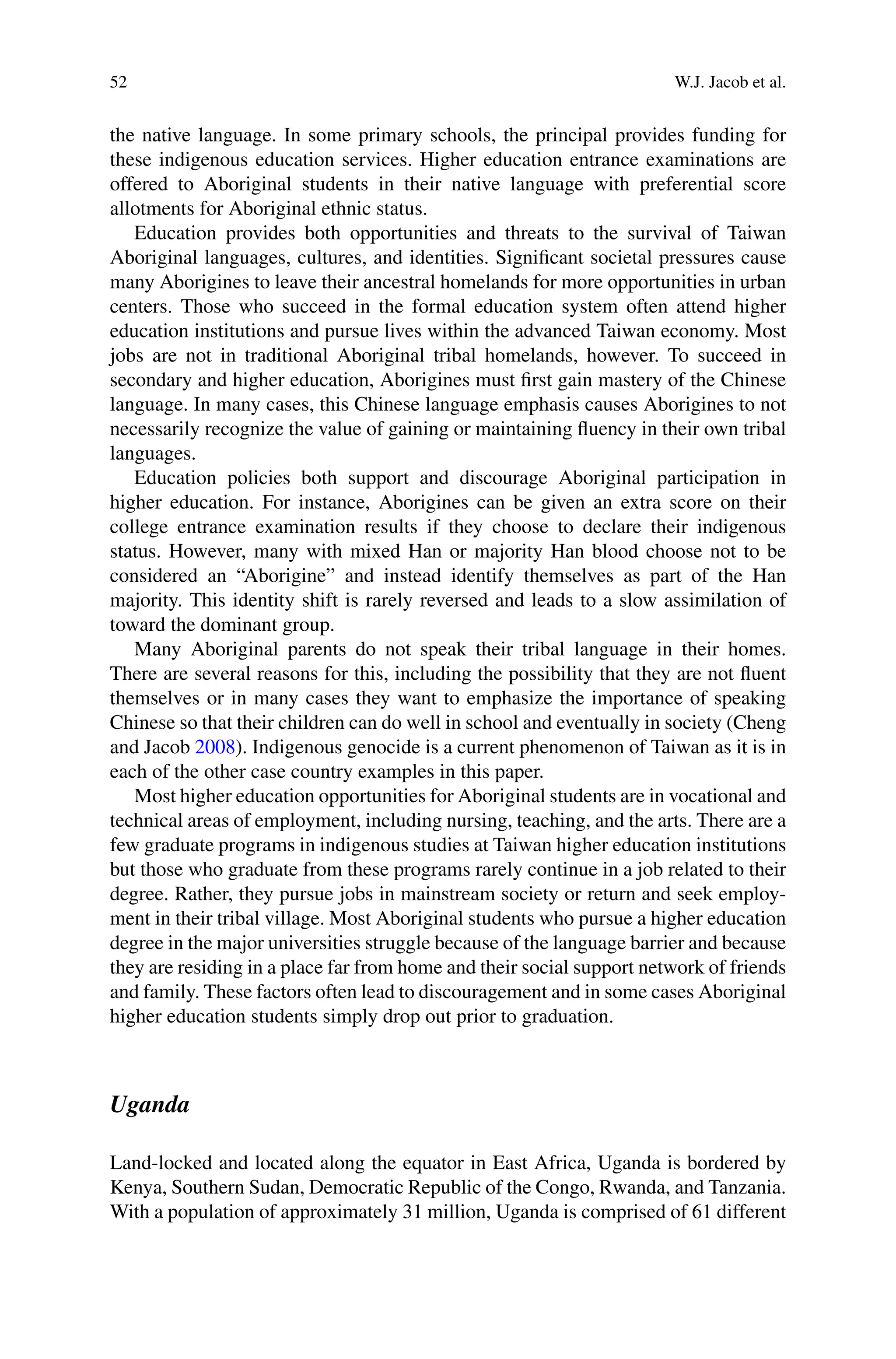
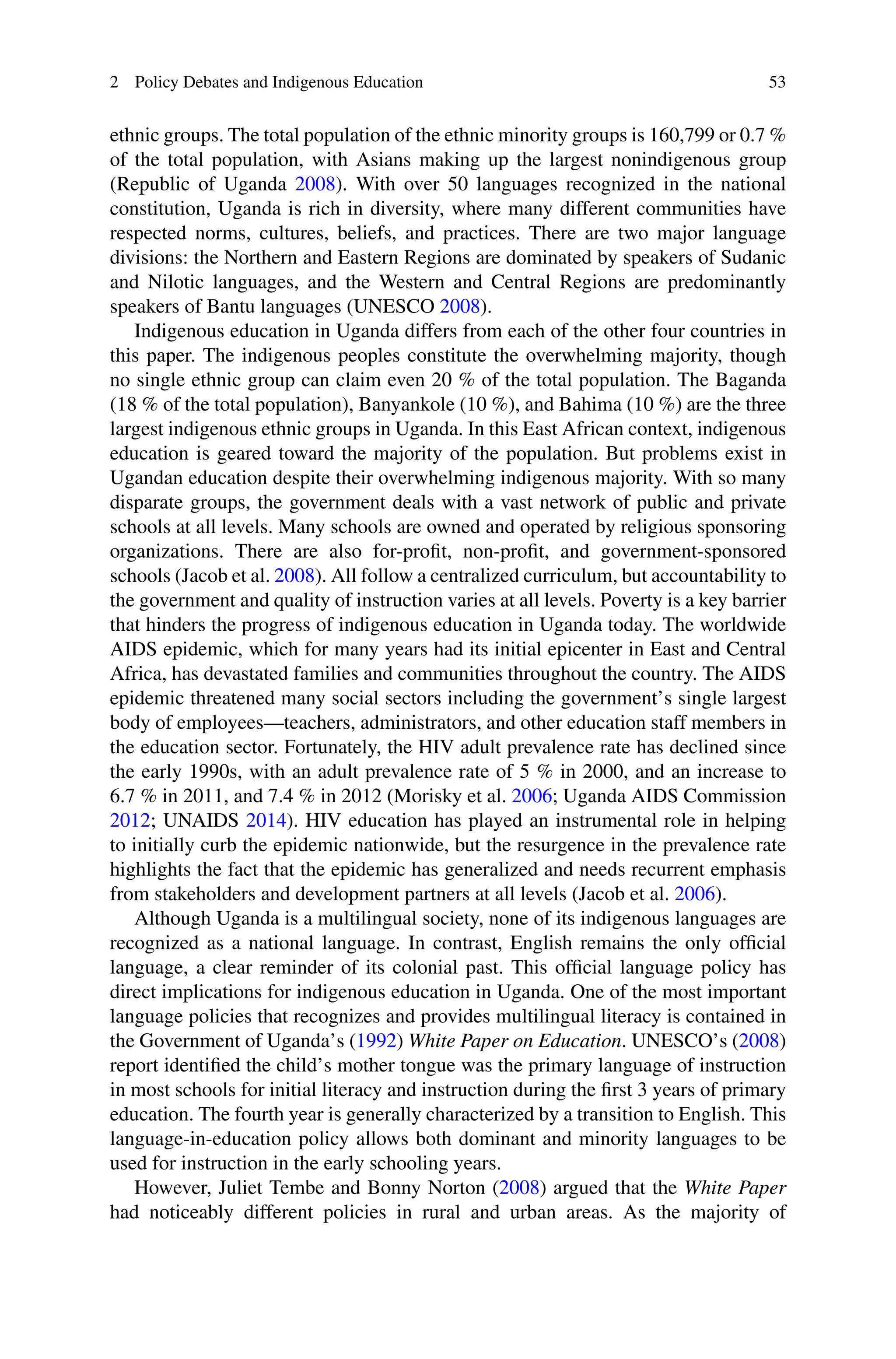

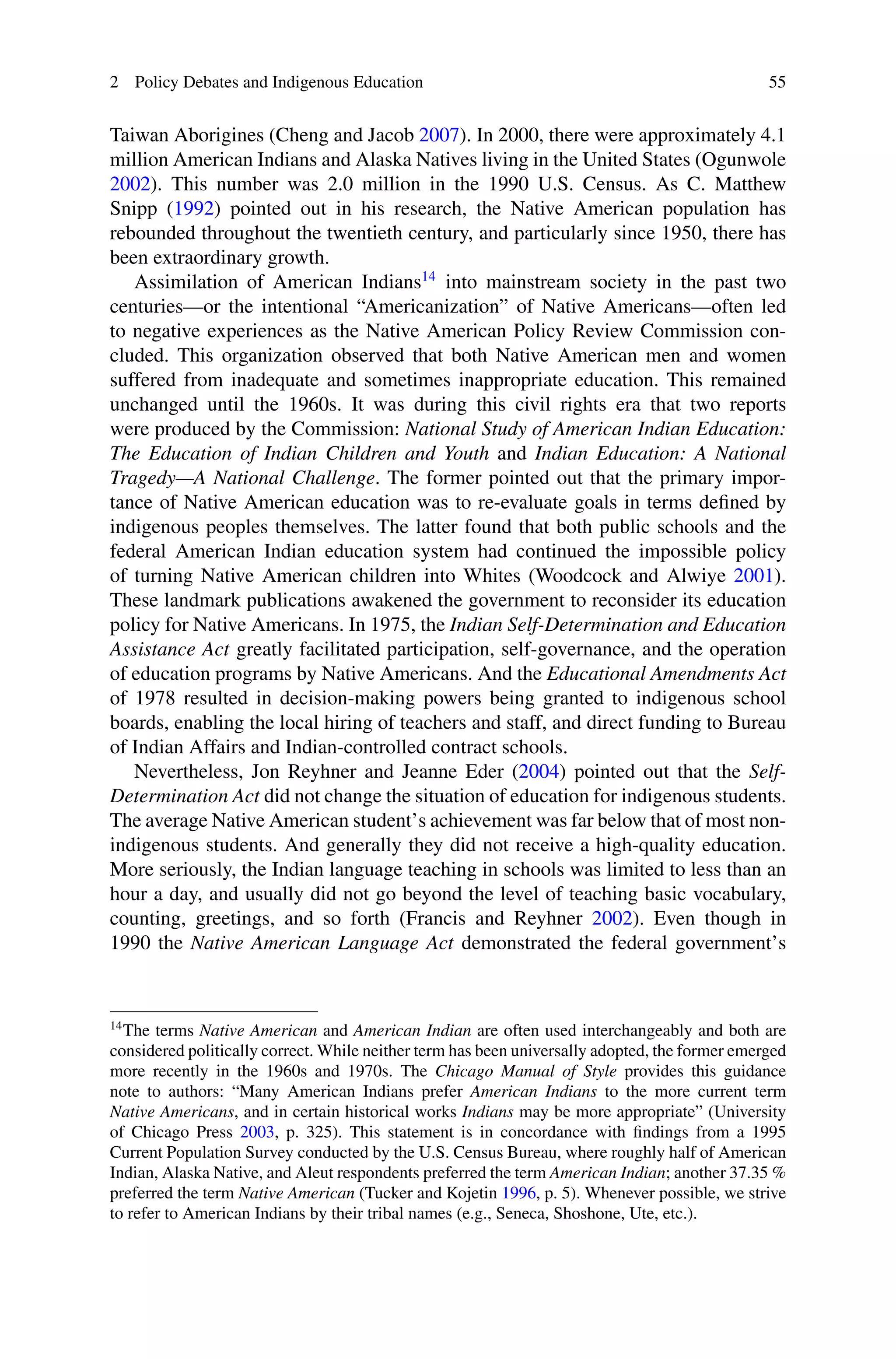
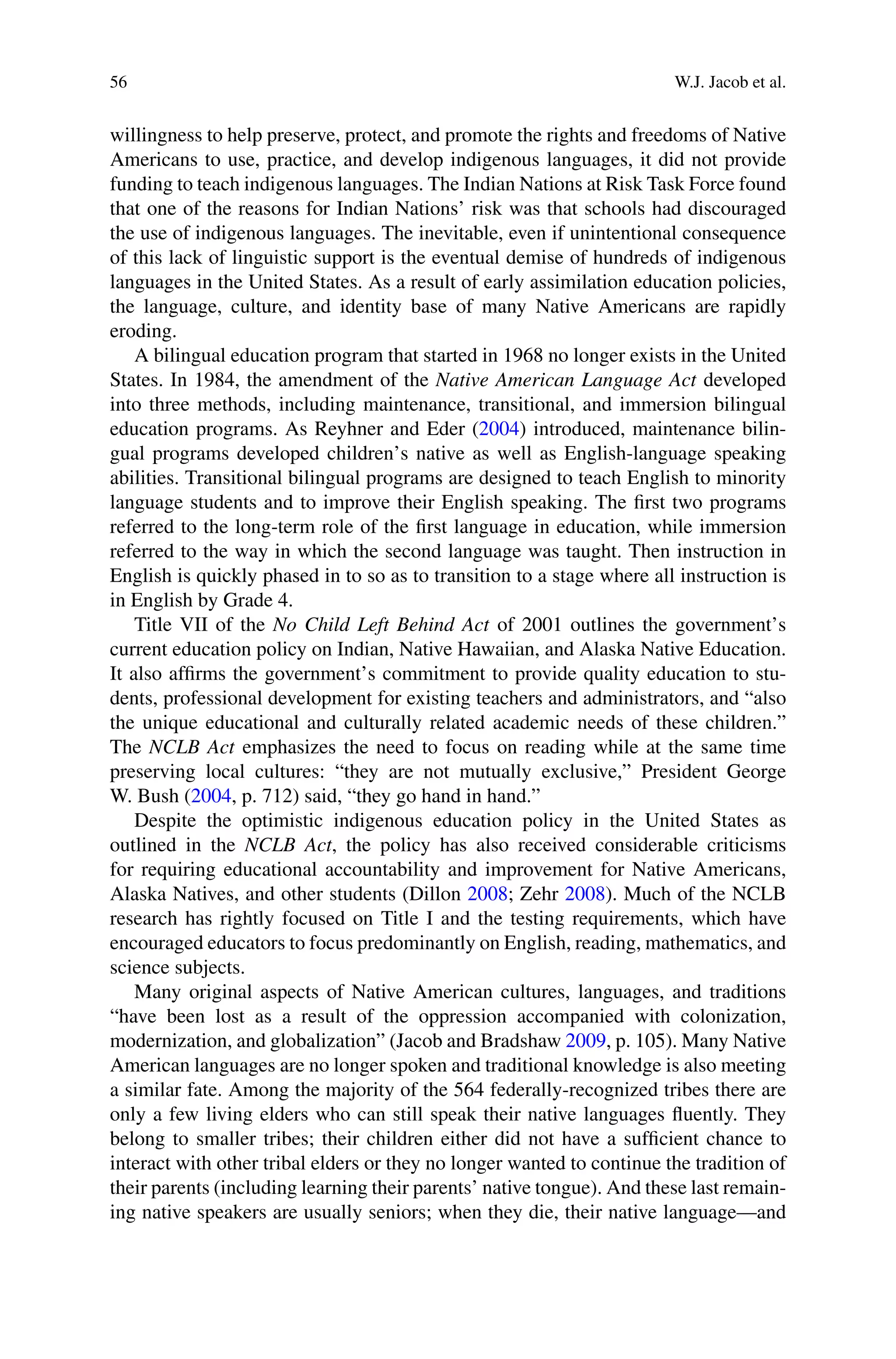
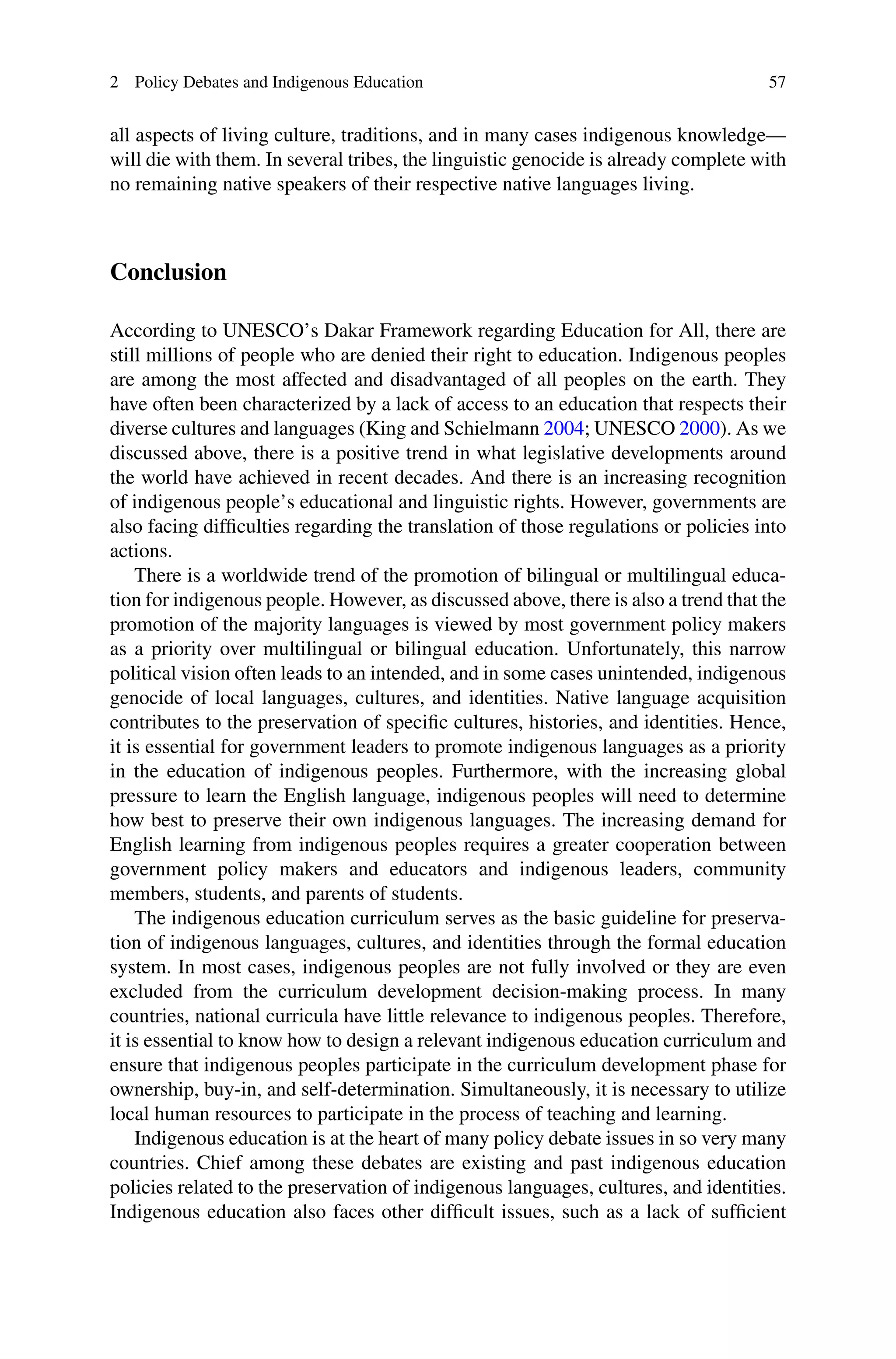
![58 W.J. Jacob et al.
funding, lack of qualified teachers and learning materials, lack of human resources,
lack of a relevant environment for using indigenous knowledge, limited access to
higher education for indigenous peoples, conflicts between indigenous religions
and politics, and the dilemma between modernization and globalization pressures
and traditional preservation. At the beginning of the twenty-first century and with
a topic as important as indigenous education, it is crucial for both government and
indigenous communities to collaborate together in order to provide innovative and
relevant approaches which can help protect and promote indigenous languages,
cultures, and identities. Since education is a universal human right, indigenous
education should also be a human right and be designed with, by, and for indigenous
peoples.
References
Bando G., Rosangela, Luis Felipe Lopez-Calva, and Harry A. Patrinos. 2004. Child labor, school
attendance, and indigenous households: Evidence from Mexico. In Understanding Children’s
Work Project Working Paper Series. Washington, DC: The World Bank.
Bellwood, Peter. 2009. Formosan prehistory and Austronesian dispersal. In Austronesian Taiwan:
Linguistics, history, ethnology, prehistory, ed. David Blundell, Rev. ed., 336–364. Berkeley,
CA: Phoebe Apperson Hearst Museum of Anthropology.
Bellwood, Peter, James J. Fox, and Darrell Tyron (eds.). 1995. The Austronesians: Historical and
comparative perspectives. Canberra: Australian National University.
Bellwood, Peter, Geoffrey Chambers, Malcolm Ross, and Hsiao-chun Hung. 2011. Are ‘Cultures’
inherited? Multidisciplinary perspectives on the origins and migrations of Austronesian-
Speaking peoples prior to 1000 BC. In Investigating archaeological cultures: Material culture,
variability and transmission, ed. Benjamin W. Roberts and Marc Vander Linden, 321–354.
New York: Springer.
Blundell, David. 2009. Austronesian Taiwan: Linguistics, history, ethnology, prehistory. Rev. ed.
Berkeley, CA: Phoebe Apperson Hearst Museum of Anthropology.
Blussé, Leonard, and Natalie Everts (eds.). 2009. The Formosan encounter: Notes on Formosa’s
Aboriginal society: A section of documents from Dutch archival sources (Volume III: 1646–
1654). 臺北市: 順益臺灣原住民博物館 [Taipei: Shung Ye Museum of Formosan Aborigines].
Blussé, Leonard, Natalie Everts, and Evelien Frech (eds.). 1999. The Formosan encounter: Notes
on Formosa’s Aboriginal society: A section of documents from Dutch archival sources (Volume
I: 1623–1635). 臺北市: 順益臺灣原住民博物館 [Taipei: Shung Ye Museum of Formosan
Aborigines].
Brock-Utne, Birgit. 2000. Whose education for all? The recolonization of the African mind.
New York: Falmer Press.
Bush, George W. 2004. Remarks on signing the executive order on American Indian and Alaska
Native education. Weekly Compilation of Presidential Documents 40(18): 710–713.
Champagne, Duane, and Ismael Abu-Saad. 2006. Introduction: Seeking common ground through
education. In Indigenous education and empowerment: International perspectives, ed. Ismael
Abu-Saad and Duane Champagne, 1–12. Oxford: AltaMira Press.
Cheng, Sheng Yao, and W. James Jacob. 2007. A comparative case study on indigenous educational
policies between Taiwan and the United States. Comparative Education 63(2): 40–78.
Cheng, Sheng Yao, and W. James Jacob. 2008. American Indian and Taiwan Aboriginal education:
Indigenous identity and career aspirations. Asia Pacific Education Review 9(3): 233–247.](https://image.slidesharecdn.com/jacobliulee2015booksection39-61policydebatesindigenouseducation-150128074332-conversion-gate01/75/Policy-Debates-and-Indigenous-Education-The-Trialectic-of-Language-Culture-and-Identity-20-2048.jpg)
![2 Policy Debates and Indigenous Education 59
Council of Indigenous Peoples, Executive Yuan (CIPEY). 行 政 院 原 住 民 族 委 員 會.
2012. 原 住 民 人 口 數 統 計 資 料 [Materials on Aboriginal population statistics]. 臺
北 市: 行 政 院 原 住 民 族 委 員 會 [Taipei: Council of Indigenous Peoples, Exec-
utive Yuan (branch)]. Retrieved from, http://www.apc.gov.tw/portal/docDetail.html?CID=
940F9579765AC6A0&DID=0C3331F0EBD318C26CAD82CF9A8D8DC7
Department of Household Registration Affairs (DHRA), Ministry of the Interior 內政部戶政
司. 2012. 內政部統計月報 [Monthly bulletin of interior statistics]. 臺北市: 內政部 [Taipei:
Ministry of the Interior]. Retrieved from, http://sowf.moi.gov.tw/stat/month/list.htm
Dillon, Michael. 2002. Uyghur language and culture under threat in Xinjiang. Central Asia
Caucasus Analyst 4(14): 6–9.
Dillon, Sam. 2008. Under “No Child” law, even solid schools falter. The New York Times, p. A1
(http://www.nytimes.com/2008/10/13/education/13child.html?pagewanted=all) (2008/13/30).
Dwyer, Arienne M. 1998. The texture of tongues: Languages and power in China. In Nationalism
and ethnoregional identities in China, ed. William Safran, 68–85. London: Frank Cass.
Flores-Crespo, Pedro. 2007. Ethnicity, identity and educational achievement in Mexico. Interna-
tional Journal of Educational Development 27(3): 331–339.
Francis, Norbert, and Rafael Nieto Andrade. 2000. Mexico: The challenge of literacy and
multilingualism. Childhood Education 76(6): 374–380.
Francis, Norbert, and Jon Reyhner. 2002. Language and literacy teaching for indigenous educa-
tion: A bilingual approach. Clevedon: Multilingual Matters.
Gladney, Dru. 1999. Making Muslims in China: Education, Islamicization and representation.
In China’s national minority education: Culture, schooling, and development, ed. Gerard A.
Postiglione. New York: Falmer Press.
Government of Uganda. 1992. Government White Paper on the education policy review commis-
sion report. Kampala: Government of Uganda.
Hall, Gillette, and Harry Anthony Patrinos (eds.). 2005. Indigenous peoples, poverty and human
development in Latin America: 1994–2004. Basingstoke: Palgrave Macmillan.
Hannum, Emily. 2002. Educational stratification by ethnicity in China: Enrollment and attainment
in the early reform years. Demography 39(1): 95–117.
Hathaway, Michael. 2010. The emergence of indigeneity: Public intellectuals and an indigenous
space in Southwest China. Cultural Anthropology 25(2): 301–333.
Hernandez-Zavala, Martha, Harry Anthony Patrinos, Chris Sakellariou, and Joseph Shapiro. 2006.
Quality of schooling and quality of schools for indigenous students in Guatemala, Mexico, and
Peru. Washington, DC: The World Bank.
International Labour Organisation (ILO). 1989. Convention 169 concerning indigenous and tribal
peoples in independent countries. Rio de Janeiro: ILO.
Jacob, W. James. 2006. Social justice in Chinese higher education: Regional issues of equity and
access. International Review of Education 52(1/2): 149–169.
Jacob, W. James, and Burk Bradshaw. 2009. Native American cultures: Peace traditions. In Oxford
international encyclopedia of peace, ed. Nigel Young, 104–107. New York: Oxford University
Press.
Jacob, W. James, and Pin-Hsi Chen. 2012. Ethnicity. In Cultural sociology of the Middle East,
Asia, and Africa, ed. Peter J. Seybolt, 29–32. Los Angeles: Sage.
Jacob, W. James, Donald E. Morisky, Yusuf K. Nsubuga, and Steven J. Hite. 2006. Evaluation
of HIV/AIDS education programs in Uganda. In Overcoming AIDS: Lessons learned from
Uganda, ed. Donald E. Morisky, W. James Jacob, Yusuf K. Nsubuga, and Steven J. Hite, 63–83.
Greenwich, CT: Information Age Publishing.
Jacob, W. James, Donald B. Holsinger, and Christopher B. Mugimu. 2008. Private secondary
education in Uganda: Implications for planning. Teachers College Record 110(4): 867–893.
Johnson, Bonnie. 2000. The politics, policies, and practices in linguistic minority education in the
People’s Republic of China: The case of Tibet. International Journal of Educational Research
33(6): 593–600.](https://image.slidesharecdn.com/jacobliulee2015booksection39-61policydebatesindigenouseducation-150128074332-conversion-gate01/75/Policy-Debates-and-Indigenous-Education-The-Trialectic-of-Language-Culture-and-Identity-21-2048.jpg)
![60 W.J. Jacob et al.
King, Linda, and Sabine Schielmann. 2004. The challenge of indigenous education: Practice and
perspectives. Paris: UNESCO.
Kormondy, Edward J. 2002. Minority education in inner Mongolia and Tibet. International Review
of Education 48(5): 377–401.
Kwong, Julia, and Hong Xiao. 1989. Educational equality among China’s minorities. Comparative
Education 25(2): 229–243.
Lewis, M. Paul, Gary F. Simons, and Charles D. Fennig (eds.). 2013. Ethnologue: Languages
of the world, 17th ed. Dallas: SIL International. Retrieved from, http://www.ethnologue.com.
Accessed 10 Jan 2014.
Li, Paul Jen-kuei 李壬癸. 1997. 台灣南島族群的族群與遷徙 [The Austronesians of Taiwan
and dispersal]. Taiwan Nan Dao Min Zu De Zu Qun Yu Qian Xi 臺北市: 常民文化 [Taipei:
Formosa Folkways].
Li, Paul Jen-kuei 李壬癸. 2009. Formosan languages: The state of the art. In Austronesian Taiwan:
Linguistics, history, ethnology, prehistory, ed. David Blundell, Rev. ed., 47–70.. Berkeley, CA:
Phoebe Apperson Hearst Museum of Anthropology.
Mackerras, Colin. 1999. Religion and the education of China’s minorities. In China’s national
minority education: Culture, schooling, and development, ed. Gerard A. Postiglione. New York:
Falmer Press.
Mackerras, Colin. 2003. China’s ethnic minorities and globalisation. London: Routledge Curzon.
Majola, Kjersti. 2006. Language and education in Uganda: An encounter with the national
indigenous language forum. Paper presented at the languages and education in Africa LEA
conference, Norway, June 2006.
May, Stephen, and Sheila Aikman. 2003. Indigenous education: Addressing current issues and
developments. Comparative Education 39(2): 139–145.
Ministry of Education, ROC (TMOE). 2010a. Aboriginal education. Taipei: TMOE.
Ministry of Education, ROC (TMOE). 2010b. Overview of Aboriginal students 2010. [98 學年原
住民學生概況分析.]. Taipei: Department of Statistics, TMOE.
Ministry of Justice, ROC. 2008. Status Act for Indigenous Peoples [原住民身分法]. Laws and
Regulations Database of the Republic of China [全國法規資料庫]. Taipei: Ministry of Justice.
Retrieved from, http://law.moj.gov.tw/Eng/LawClass/LawAll.aspx?PCode=D0130001
Modiano, Nancy. 1972. Indian education in the Chiapas Highlands. New York: Holt, Rinehart and
Winston.
Morisky, Donald E., W. James Jacob, Yusuf K. Nsubuga, and Steven J. Hite (eds.). 2006. Over-
coming AIDS: Lessons learned from Uganda. Greenwich, CT: Information Age Publishing.
National Bureau of Statistics. 2012. China statistical yearbook 2012. Beijing: China Statistics
Press.
National People’s Congress. 1982. Constitution of the People’s Republic of China. Beijing:
National People’s Congress.
National People’s Congress. 1995. Education Law of the People’s Republic of China. Beijing:
National People’s Congress.
Ogunwole, Stella U. 2002. Census 2000 brier: The American Indian and Alaska Native population:
2000. Washington, DC: U.S. Department of Commerce, Economic and Statistics Administra-
tion, U.S. Census Bureau.
Parod, Icyang 夷將 拔路兒, (ed.). 2008. 臺灣原住民族運動史料彙編(上) [Documentary
Collection on the Indigenous Movement in Taiwan—Volume I]. 臺北縣 (市): 國史館與行政
院原住民族委員會 [Taipei (County): Academia Historica and Council of Indigenous Peoples,
Executive Yuan].
Postiglione, Gerard A. 1999. Introduction: State schooling and ethnicity in China. In China’s
national minority education: Culture, schooling, and development, ed. Gerard A. Postiglione.
New York: Falmer Press.
Pu, Cung-Cheng, 浦忠成 (Pasuya Poiconu). 2002. Trends in the development of teaching Taiwan
Aboriginal languages. [台灣原住民族語教學發展之趨勢.] 原住民教育季刊 [Aboriginal
Education Quarterly] 25: 56–71.](https://image.slidesharecdn.com/jacobliulee2015booksection39-61policydebatesindigenouseducation-150128074332-conversion-gate01/75/Policy-Debates-and-Indigenous-Education-The-Trialectic-of-Language-Culture-and-Identity-22-2048.jpg)
![2 Policy Debates and Indigenous Education 61
Reinke, Leanne. 2004. Globalisation and local indigenous education in Mexico. International
Review of Education 50(5/6): 483–496.
Republic of Uganda. 2008. The state of Uganda population report 2008. In The role of culture,
gender and human rights in social transformation and sustainable development. Kampala:
UNFPA Uganda.
Reyhner, Jon, and Jeanne Eder. 2004. American Indian education: A history. Norman: University
of Oklahoma Press.
Rippberger, Susan J. 1993. Ideological shifts in bilingual education: Mexico and the United States.
Comparative Education Review 37(1): 50–61.
Shih, Cheng-Feng 施正鋒. 2005. 台灣原住民族政治與政策 [Politics and Policies of Taiwan
Aboriginal Peoples]. 臺北市: 翰蘆 [Taipei: Hanlu].
Snipp, C. Matthew. 1992. Sociological perspectives on American Indians. Annual Review of
Sociology 18(1): 351–371.
State Council of the People’s Republic of China. 1988. The regulations on the eradication of
illiteracy. Beijing: State Council of the People’s Republic of China.
Tembe, Juliet, and Bonny Norton. 2008. Promoting local languages in Ugandan primary schools:
The community as stakeholder. The Canadian Modern Language Review 65(1): 33–60.
Tucker, Clyde, and Brian Kojetin. 1996. Testing racial and ethnic origin questions in the CPS
supplement. Monthly Labor Review 119(9): 3–7.
Uganda AIDS Commission. 2012. Global AIDS response progress report. Kampala: Uganda AIDS
Commission.
UNAIDS. 2014. HIV and AIDS estimates: Uganda. Geneva: UNAIDS. Available online at: http://
www.unaids.org/en/regionscountries/countries/uganda. Accessed 11 Jan 2014.
UNESCO. 2000. The Dakar framework for action. Dakar: UNESCO.
UNESCO. 2006. UNESCO and indigenous peoples: Partnership to promote cultural diversity.
Paris: UNESCO.
UNESCO. 2008. Improving the quality of mother tongue-based literacy and learning: Case studies
from Asia, Africa and South America. Bangkok: UNESCO Bangkok.
United Nations. 1948. The universal declaration of human rights. New York: United Nations
General Assembly.
United Nations. 1966. International covenant on civil and political rights. New York: United
Nations.
United Nations. 1992. Agenda 21. Rio de Janeiro: United Nations Conference on Environment and
Development (UNCED).
United Nations. 2007. United Nations declaration on the rights of indigenous peoples. New York:
United Nations.
United Nations. 2008. Integration of indigenous people’s perspectives in country development
processes. New York: United Nations.
University of Chicago Press. 2003. The Chicago manual of style, 15th ed. Chicago: University of
Chicago Press.
University of Chicago Press. 2010. The Chicago manual of style, 16th ed. Chicago: University of
Chicago Press.
Waldron, Jeremy. 2003. Indigeneity? First Peoples and last occupancy. The New Zealand Journal
of Public and International Law 1(1): 55–82.
Wang, Chiu Yi 汪秋一. 2007. The Adjustments and Review of Taiwan’s Preferential Policy for
Aboriginal Students in Education Advancements. [原住民學生升學優待政策的變革與檢討.]
原教界 [Aboriginal Education World] 14: 4–5.
Woodcock, Don B., and Osamn Alwiye. 2001. The antecedents of failure and emerging hope:
American Indians and public higher education. Education 121(4): 810–820.
Yi, Lin. 2008. Cultural exclusion in China: State education, social mobility and cultural difference.
London/New York: Routledge.
Zehr, Mary Ann. 2008. Tribal representatives complain of little help on NCLB flexibility.
Education Week 28(4): 18–19.](https://image.slidesharecdn.com/jacobliulee2015booksection39-61policydebatesindigenouseducation-150128074332-conversion-gate01/75/Policy-Debates-and-Indigenous-Education-The-Trialectic-of-Language-Culture-and-Identity-23-2048.jpg)